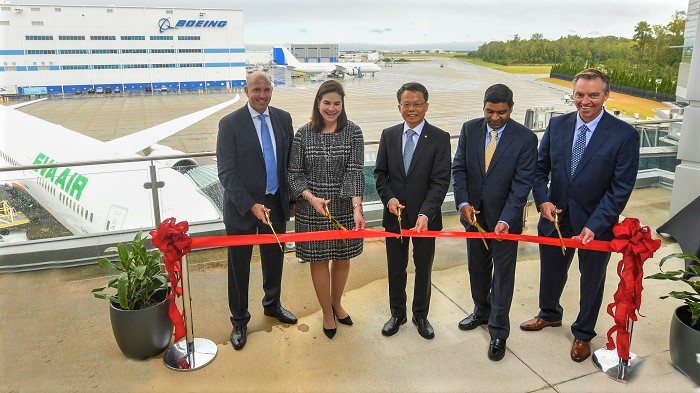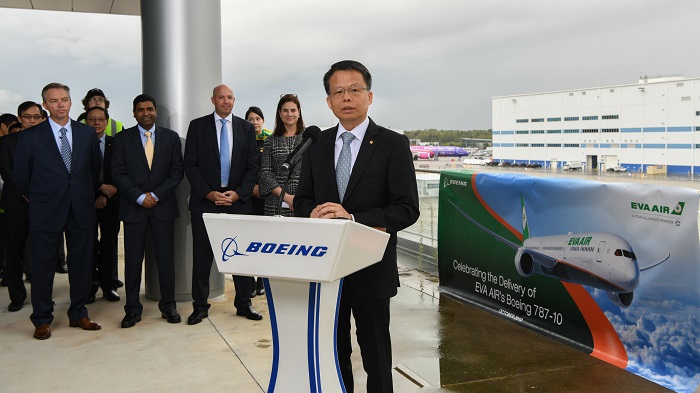Siaran Pers
EVA Adds Fourth New Boeing 787-10 Dreamliner
Oct 7, 2019
EVA Air added its fourth 787-10 Dreamliner, aircraft number B-17805, at the Boeing assembly factory in North Charleston, South Carolina on Oct. 7, 2019. EVA President Clay Sun led a delegation from Taipei, Taiwan to take delivery of the airline’s newest aircraft and, alongside Ms. Christy Reese, Vice President of Boeing Commercial Sales and Marketing – Asia Pacific and Mr. Mahendra Nair, General Manager of GEnx Product Line, commemorated the event with a ribbon cutting. EVA ferried the new Dreamliner to Taiwan the same day and began preparations to use the new plane to upgrade service.

EVA has already deployed new Dreamliners on routes from Taipei to Tokyo, Osaka, Hong Kong and Vienna. It will start flying one of the aircraft to Brisbane later this month and extend 787 operations to Vancouver in the first quarter of 2020. Information about the airline’s routes and services is available at www.evaair.com.
“Fuel efficiency and cabin comfort are two key factors that determine a commercial jetliner’s competitiveness in the global aviation market,” said EVA President Clay Sun. “The Boeing Dreamliner’s reliable performance and advanced aviation technologies make it an excellent choice for the aircraft we need to continue growing our route network and providing our passengers with safe, comfortable flights.”

Technologies used to build the Boeing 787 Dreamliner make the aircraft more environmentally efficient. It is constructed of lighter composite materials such as carbon fiber and more than 50% of the aircraft’s total weight comes from these materials, including the fuselage, wings and engine fan blades. Compared to traditional aluminum alloy fuselage construction, these advanced materials significantly decrease the aircraft’s overall weight and likelihood of metal fatigue or corrosion, reducing maintenance costs. Replacing fluorescent tubes with LED lights lowers power demand by almost half.
GE’s advanced GEnx engines reduce fuel consumption and greenhouse gas emissions by 20%, compared to power systems on traditional wide-body aircraft. The 787’s high fuel efficiencies and range capabilities equip EVA to further elevate operational performances.
Boeing also engineered its Dreamliners to enhance cabin comfort. The Boeing 787 is equipped with an advanced air filtration system that improves cabin air. The composite materials make the 787 fuselage more airtight. Compared with traditional commercial jets, the 787’s cabin humidity can be increased three-to-four times, eliminating the drying inflight atmosphere. The aircraft’s cabin pressure can also be controlled to make the altitude feel like the optimal 6,000 ft. instead of the standard 8,000 ft., boosting passengers’ blood-oxygen levels and reducing headaches and fatigue. Specially designed engine housings significantly reduce noise and give passengers quieter, more comfortable inflight environments.
In addition to giving passengers the comforts and conveniences of the Boeing Dreamliner’s advanced aviation technologies, EVA worked hard to further elevate cabin comfort.
EVA chose Designworks, a BMW company, to create new Royal Laurel Class business seats. It selected Teague, a global design consultancy recognized for work in aviation, to develop new Economy Class seats and RECARO, a German manufacturer known for sports car interiors, to produce them. EVA is making these investments to give passengers better flying experiences and advance its dedication to five-star airline service.
EVA is adding a total of 24 Dreamliners to its fleet. Starting in 2018, it began to take delivery of 787-9 Dreamliners and now operates four of the aircraft in that model. To celebrate its 30th anniversary this year, the airline has begun to introduce 787-10s, the newest and largest model in the Dreamliner family, further upgrading services on more routes. By 2022, the airline will be operating 16 more 787-10s.
The Boeing 787-10 is 68.3 meters (224.1 ft.) long, approximately 5 meters (16.4 ft.) longer than 787-9. EVA configured its 787-10s for 342 passengers with 34 in Royal Laurel Class business and 308 in Economy. This new Dreamliner model seats eight more passengers in Royal Laurel and 30 more in Economy Class than its sister 787-9 aircraft.
The Boeing 787-10 also has a larger belly capacity and holds more air freight than the 787-9. Using EVA’s Taipei-Japan routes as an example, the 787-10s can carry one-to-two tons of additional cargo, including fresh seafood, fragile fruit and sensitive high-tech products, along with a full load of passengers. During slower travel seasons, the 787-10’s larger belly capacity will help EVA increase cargo revenue and boost overall operating performance.
